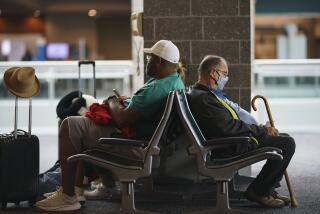Safe Arrival May Be Up to Traveler
- Share via
Whether you survive an emergency on board an airliner may depend on factors entirely beyond your control, such as the reactions to the crew or the location of the aircraft at the time the crisis arises.
Still, in the aftermath of the recent Indian Airlines hijacking, experts say there are many measures you can take to tilt the odds in your favor. During a hijacking, they say, rule No. 1 is to remain calm and avoid drawing attention to yourself.
“If anyone is going to be selected as a target for hostility by any process other than a random choice, it is going to be the person who stands out,” Nick Catrantzos, director of corporate security at Kroll Associates in Los Angeles, said recently.
“This means that anyone visibly affluent, defiant, attention-getting or confrontational is going to be asking for it in the eyes of the terrorist hijacker.”
Indeed, the one person to die in the eight-day Indian Airlines hijacking was a young man whose throat was slashed with a knife for defying instructions not to look at the hijackers.
While emphasizing that the risk of being hijacked is very remote, former U.S. State Department overseas security officer Kent Brown notes that one of the first things hijackers often do is collect IDs and look for somebody who fits the profile of whatever group or cause they’re against.
“If I was traveling and I was in the military reserves and I had an ID card, I’d probably leave it at home,” said Brown, who heads Pinkerton Global Intelligence Services.
“You may also want to think about the business cards that you have in your wallet. A business card from an information service can be misconstrued as being from some sort of intelligence service.”
Navy diver Robert Dean Stethem, the only person to die in the infamous 1985 hijacking of a TWA airliner in Beirut, was singled out and shot because he was carrying military identification, according to other passengers.
A tip sheet on hijacking situations prepared by the U.S. State Department also advises captives to refrain from alcohol, comply with all orders, avoid a sense of despair, withhold unsolicited information and “don’t try to be a hero.”
Consultants at the London-based intelligence firm Control Risks Group say it’s also wise to eat all food given you; to surrender documents or valuables willingly; and, in the event of a rescue attempt, to obey the instructions of the assault team (if told to get down, do so and stay down).
Nancy Claussen, a cabin safety inspector for the Federal Aviation Administration, urges air travelers to be aware of their surroundings, even under more normal flight circumstances.
“A passenger who is aware of where they are in the aircraft relative to the exits; a passenger who is aware of the safety features on the aircraft; a passenger who is aware of the locations of the oxygen masks, the locations of doors, the locations of the escape-path lighting--that is a passenger who is probably going to effect a more positive outcome for themselves,” Claussen said.
She encourages all air travelers to pay attention to the preflight safety demonstration and to study the safety card in front of every passenger. “It’s a short course in getting yourself out alive,” she said.
She also urges passengers to keep their seat belts fastened. Turbulence poses one of the greatest threats to air travelers, and nearly all injuries related to turbulence could be avoided if people would stay buckled up.
Although airlines don’t always notify the FAA of turbulence-caused injuries, the FAA Web site is chock full of incident reports describing turbulent events.
Typical of them is the report of 15 people who were hurt in September when their United Airlines flight from Los Angeles to San Francisco encountered turbulence. “Everybody went straight to the ceiling,” passenger Ronald Kalio recalled. “There were two stewardesses that spent the rest of the trip in the aisles. They were knocked out.”
The 15 victims were not buckled up, flight attendants said.
The previous year seven people on a Continental Airlines flight from Los Angeles to Hawaii were battered when their plane met with turbulence over the Pacific Ocean.
“The plane just immediately fell,” passenger Adam Paul of Provo, Utah, said at the time. “People were glued to the ceiling--and then they just dropped.”
To reduce the risk of perishing in an on-board fire, experts advise air travelers to wear cotton, wool and leather rather than synthetic fibers, which can melt onto your skin at relatively low temperatures. For this reason, women should not wear nylons or tights on planes.
“Even hair spray is extremely flammable,” said Candace Kolander, safety coordinator of the 46,000-member Assn. of Flight Attendants.
But by far the greatest danger to the air traveler comes from overhead. Don’t stack or cram items into overhead bins, she said, and always open the compartments slowly.
There are no fewer than 4,500 injuries every year due to falling carry-on luggage on the 12 major U.S. carriers, Kolander said.
Also, in the event you are told to evacuate the plane, do so as quickly as possible--and that means leaving your luggage behind.
As for choosing a “safe seat,” Andrew Weir, the author of the new book “The Tombstone Imperative: The Truth About Aircraft Safety,” says that for crash survivability, the best seats are those closest to an exit and at the rear of the plane.
Much of the impact of a crash would likely be absorbed by the front of the airliner before it reached those in the rear.
Some readers will no doubt recall that in the worst single-aircraft crash--the 1985 Japan Airlines flight that struck a mountain ridge en route from Tokyo to Osaka, killing 520 people--all four survivors had been seated in the last rows of the shattered Boeing 747.
The Times is interested in hearing about your experiences as a business traveler and as someone doing business in the international marketplace. Please contact us at [email protected].
More to Read
Sign up for The Wild
We’ll help you find the best places to hike, bike and run, as well as the perfect silent spots for meditation and yoga.
You may occasionally receive promotional content from the Los Angeles Times.






